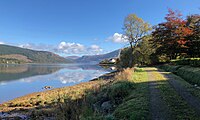Loch Fyne
| Loch Fyne | |
|---|---|
| Loch Fyne (Loch Gilp, Loch Shira) | |
| Vine (wine) lake Loch Fine or Loch Fyne Error {{native name checker}}: parameter value is malformed (help) | |
 Head of the loch from near St Catherines | |
| Location | Cowal, Argyll and Bute, Scotland. |
| Coordinates | 56°10′19″N 5°06′00″W / 56.172°N 5.100°W, grid reference NN0765202128 |
| Type | Sea Loch |
| River sources | Curl Arstich burn, river garron river Fyne lingerton burn king las water allt na craobh uinsinn Allt oigh Allt oich allt na Craig Abhainn Mor Inverneill river Allt Airigh na brodaig Douglas water dalchenna burn Allt Airigh na brodaig Abhainn Srathain Ardfenaig burn Crinan Canal Inverdrishaig water Allt an bog |
| Basin countries | Scotland, United Kingdom |
| Salinity | Seawater |
| Surface elevation | Sea Level |
| Frozen | No |
Loch Fyne (Scottish Gaelic: Loch Fìne, pronounced [l̪ˠɔx ˈfiːnə]; meaning "Loch of the Vine/Wine"), is a sea loch off the Firth of Clyde and forms part of the coast of the Cowal peninsula. Located on the west coast of Argyll and Bute, Scotland. It extends 65 kilometres (40 mi) inland from the Sound of Bute, making it the longest of the sea lochs. It is connected to the Sound of Jura by the Crinan Canal. Although there is no evidence that grapes have grown there, the title is probably honorific, indicating that the river, Abhainn Fìne river Fyne, was a well-respected river.
In the north the terrain is mountainous, with the Arrochar Alps, Beinn Bhuidhe, Glen Shira, Glen Fyne, Glen Croe, Arrochar, Tyndrum and Loch Lomond nearby.
It is overlooked by the Tinkers' Heart, an old travellers' monument.[1]
Loch Fyne is a popular area for sport diving and fishing. It is also a popular tourist destination with attractions such as Inveraray Castle and the nearby ruins of Castle MacEwen and Old Castle Lachlan.
The village of Portavadie is on the east shore of the loch. A passenger ferry traverses the loch to Tarbert from the slipway at Portavadie.
During the Second World War, the Combined Operations Training Centre on the banks of the loch, was an important military facility.[2]

Nature and conservation
Dolphins, seals and otters inhabit the loch, and basking sharks can appear in its waters during the summer months. A Ross's gull was present at the loch in early 2007.[citation needed]
In 2014 Loch Fyne was declared a Nature Conservation Marine Protected Area (NCMPA). The designation covers the entire loch northwards from a point near Otter Ferry.[3]
Crinan Canal

The Crinan Canal connects Loch Fyne at Ardrishaig and the Sound of Jura at the hamlet of Crinan itself, giving a shortcut for smaller vessels out to the Hebrides saving the longer route of going around the Kintyre peninsula. The canal was built between 1794 and 1801 when the canal was opened, under the supervision of John Rennie. In 1816 Thomas Telford redesigned parts of the canal to remedy technical issues with water supplies for the canal. There are fifteen locks along the canal's 9-mile (14 km) length.[4]
Fisheries
Loch Fyne has a reputation for its oyster fishery, and as a consequence, the loch has given its name to the once locally owned Loch Fyne Oysters and to the associated Loch Fyne Restaurants.[5] It is also notable for its herring-fishing industry, and hence the famous Loch Fyne Kipper, originally caught using the drift-net method. In the mid-19th century, Loch Fyne was the centre of the battle between the traditional drift-net fishermen and the new trawl-net fishermen who sprang up around Tarbert and Campbeltown in 1833.[6]
Several Scottish sea-fishing records have been set in the loch:
| Species | Weight lb-oz-dr |
Angler | Date | Method |
|---|---|---|---|---|
| Dogfish black mouthed | 02-13-08 (1.29 kg) | J. H. Anderson | 1977 | Boat |
| Poor cod | 01-00-00 (0.45 kg) | F. Johnstone | 1970 | Shore |
| Tadpole fish | 01-04-00 (0.57 kg) | H. Donnelly | 1995 | Shore |
| Blue whiting | 01-12-00 (0.79 kg) | J. H. Anderson | 1977 | Boat |
Gallery
-
Inveraray Bridge on Loch Fyne. The spires of Inveraray Castle can just be seen on the left.
-
Loch Fyne at Inverary harbour.
-
A view towards the north-eastern tip of the loch from St Catherines.
-
The view down Loch Fyne, from Inveraray. The Fairy Hill can be seen in the distance to the right.
See also
- Ardkinglas Railway
- Loch Fyne (Greenland), a ford named in 1823 by Douglas Clavering after this loch
References
- ^ "MSPs seek action over Tinkers' Heart in Argyll". BBC News. 2014-09-30. Retrieved 2016-12-14.
- ^ "No. 1 Combined Training Centre, Inveraray". Combinedops.com. Retrieved 2017-02-01.
- ^ "Upper Loch Fyne and Loch Goil". Scottish Natural Heritage. Retrieved 2 September 2019.
- ^ "Crinan Canal Feature Page on Undiscovered Scotland". Undiscoveredscotland.co.uk. Retrieved 2017-02-03.
- ^ Dunkley, Daniel (2016-03-27). "Loch Fyne on the block". The Sunday Times.
- ^ The Rinn-Net Fishermen, Martin
External links
- Map sources for Loch Fyne




